Purple Lemonade Auto Cannabis Strain Week-by-Week Guide
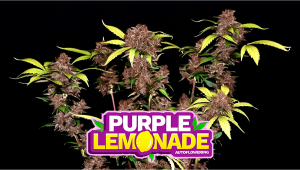
- 1. Grow specifications
- 2. Grow set up
- 3. Germination and seedling stage | week 1
- 4. Early veg | week 2
- 5. Mid veg | weeks 3-4
- 6. Transition (pre-flower) | week 5
- 7. Early flower | weeks 6-7
- 8. Mid flower (bulk phase) | weeks 8-9
- 9. Ripening and harvest | week 10
- 10. Yield and smoke report
- 11. In conclusion
Our most advanced purple genetics so far, Purple Lemonade Auto has an enormous bag appeal. Dark-colored chunky buds are frosted with THC crystals and streaked with bright orange pistils. Vibrant green sugar leaves complete the picture. The fresh bittersweet taste and the relaxing and motivating high are also top-notch.
Learn how to grow Purple Lemonade Autoflower week by week by following her progress through a real-world grow cycle. We’ll give you an insight into her seed to harvest timeline so that you can move on cruise control through all grow stages: from the vegetative phase to the pre-flowering stage to different stages of flowering.
1. Grow Specifications
Purple Lemonade Auto is one of the taller strains in FastBuds collection. The central cola may reach the height of 70–120 cm (28–47 inches) by harvest time. The bush also has much girth thanks to many strong side branches. All this means generous yields: 400–500 gr/m2(1.3–1.6 oz/ft2) indoors and 50–250 g (2–9 oz) per plant outdoors.
This cultivar has about 70% Indica in its DNA which makes it sturdy and high-yielding. The remaining 30% Sativa genes account for spacy internodes, open bush structure, and chunky loose buds. Also expect a great hybrid vigor from this variety.
And—as you may expect—most plants exhibit exquisite colors on buds and sugar leaves. Many phenos are deep purple, others have lighter shades, but all are generously sprinkled with trichomes and have a strong delicious smell. The finished product is a terpene treat with a strong kick provided by up to 22% THC.
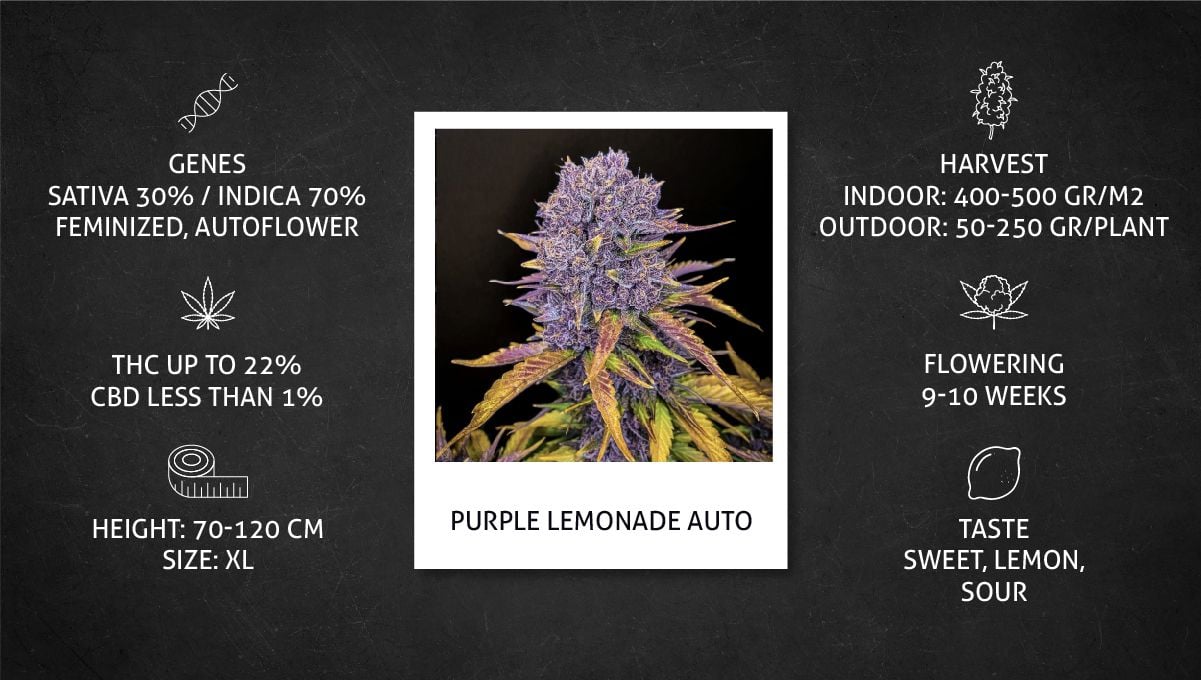
So, what can you expect when cramming Purple Lemonade Auto buds into a joint, bong bowl, or blunt? Well, you better buckle up and get ready for a sedating and deeply relaxing vibe. Her high THC content will make itself known within seconds of taking the first hit. You’ll experience it as a comforting wave that sweeps over every muscle in the body. It’ll banish tension and leave nothing but looseness and relaxation in its wake.
But the THC content shouldn’t receive all of the credit. You see, cannabis scientists have also discovered that terpenes play a major role in the subjective effects of each strain—not just the aroma and taste. Some terpenes are capable of latching onto the receptors of the endocannabinoid system, the same sites that THC and other cannabinoids bind to in order to catalyze their effects. Sure, terpenes produce their own unique effects in isolation, including the inhibition of short-term memory impairment caused by THC, and general mood elevation. However, they also team up with cannabinoids and work with them, side by side, to create a synergistic effect, known as the entourage effect.
When it comes to Purple Lemonade Auto, her fruity and earth terpenes work with THC to impart a euphoric and physical high that will get you in the mood to kick back and relax, listen to some music, dive deep into philosophical conversation, and inevitably raid the fridge at some point, too. Ultimately, this attractive cultivar is best reserved for relaxing afternoons and evenings. Far from a wake-and-bake variety (unless you have a high and impressive tolerance), this strain is best for beaches, swinging in hammocks, and slowly meandering hiking trails.
2. Grow Set Up
Purple Lemonade Auto is a relatively new variety, but there are already many detailed grow diaries online, with good photos. We chose a grow cycle where the grower didn’t have much previous experience but demonstrated great results all the same. Which shows that this variety can pretty much take care of itself.
A grower with the nick AHG2020 uses a small (2’x2’, or 60x60x200cm) Black Orchid tent—enough to fit in one autoflower, even a very large one. The light that he uses for the whole of the life cycle is a Mars Hydro TS 1000 LED which draws only 150W.
| Grow Space: | 0.37 m2 (4 ft2) | Pot Size: | 20 l (5.3 gal) |
|---|---|---|---|
| Seed to Harvest: | 10 weeks | Medium: | 50/50 soil/perlite |
| Flowering: | 6 weeks | Nutrients: | Synthetic/Organic |
| Light Cycle: | 20/4 | pH Levels: | 6.5 |
| Light Type: | LED | Day Temperature: | 26–28°C (79–82°F) |
| Watts Used: | 150 | Humidity: | 55% ↘ 40% |
The light doesn’t generate much heat, but the grower still takes ventilation very seriously: besides an exhaust fan, he has installed a small intake fan and also an 8” clip-on fan to move the air inside the tent.
Support fashioned out of a rigid wire holds a 20L (5.28 gall) non-woven grow bag. Another wire runs around the tent, about knee-high or so to prevent tent walls from collapsing due to negative pressure.
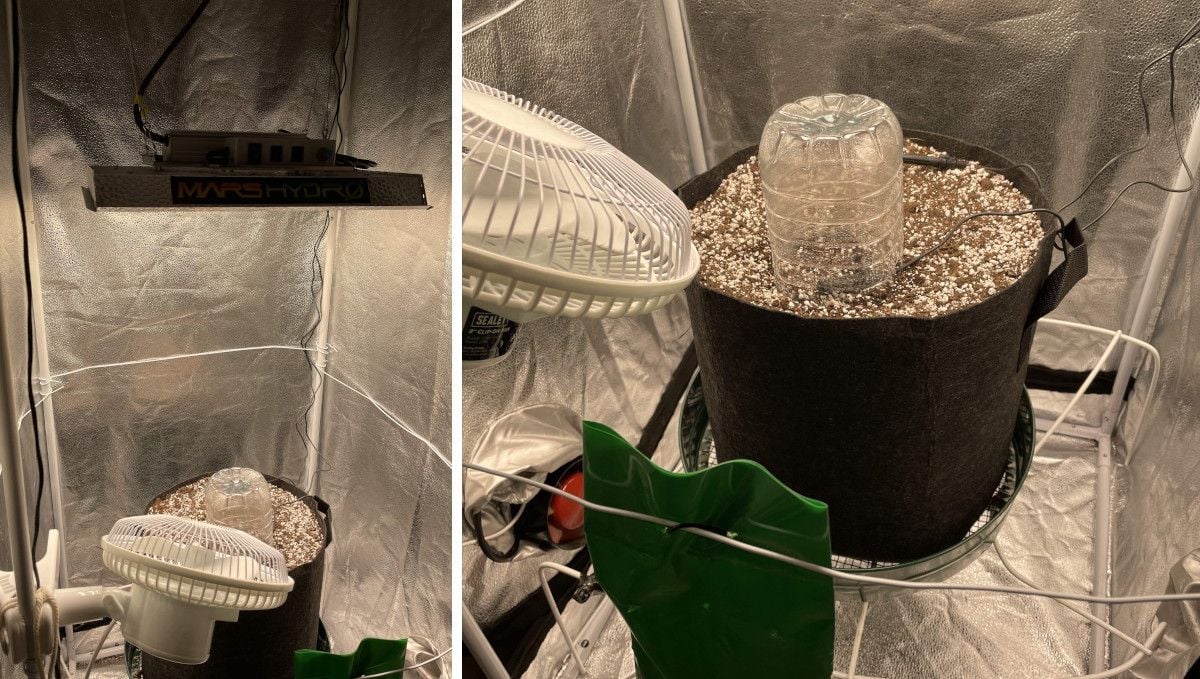
3. Germination And Seedling Stage | Week 1
Of the great number of ways to germinate cannabis seeds, you can choose any as long as you take care of two things: warm temps and moisture. When the bean has sprouted, it’s best to put it straight into the final container and not disturb its roots with transplanting later on. It’s a standard recommendation for even the most resilient of autoflowers, such as Purple Lemonade Auto.
| Plant Height: | 1“ (2.5 cm) | Humidity: | 55% |
|---|---|---|---|
| Distance to Light: | 24“ (61 cm) | Water per Day: | 0.08 gal (0.3 l) |
| Day Temp: | 82°F (28°C) | pH: | 6.5 |
| Night Temp: | 70°F (21°C) | Smell: | None |
The grower started with soaking one Purple Lemonade Auto seed for 24 hours, and then he placed it in a wet paper towel for 3 days. After that, he put the bean directly into a 20l fabric pot.
As a medium, he used a 50/50 mix of Biobizz Light soil and perlite.
Usually, people add around 20% of perlite. Perlite (for those who don’t know) makes the soil mix airy and provides roots with oxygen to breathe.
If you mix in less perlite than that, the soil retains moisture better, but breathing becomes problematic. If you mix in more perlite, there are no issues with breathing, but water retention suffers, and you’ll have to irrigate more often. So be aware of this tradeoff when choosing your soil-to-perlite proportion.
When the seed sprouted, the grower covered it with the bottom part of a plastic bottle as a humidity dome. He sprayed the area around the seedling two times a day and the inside of the dome 3 times a day to keep the humidity up.
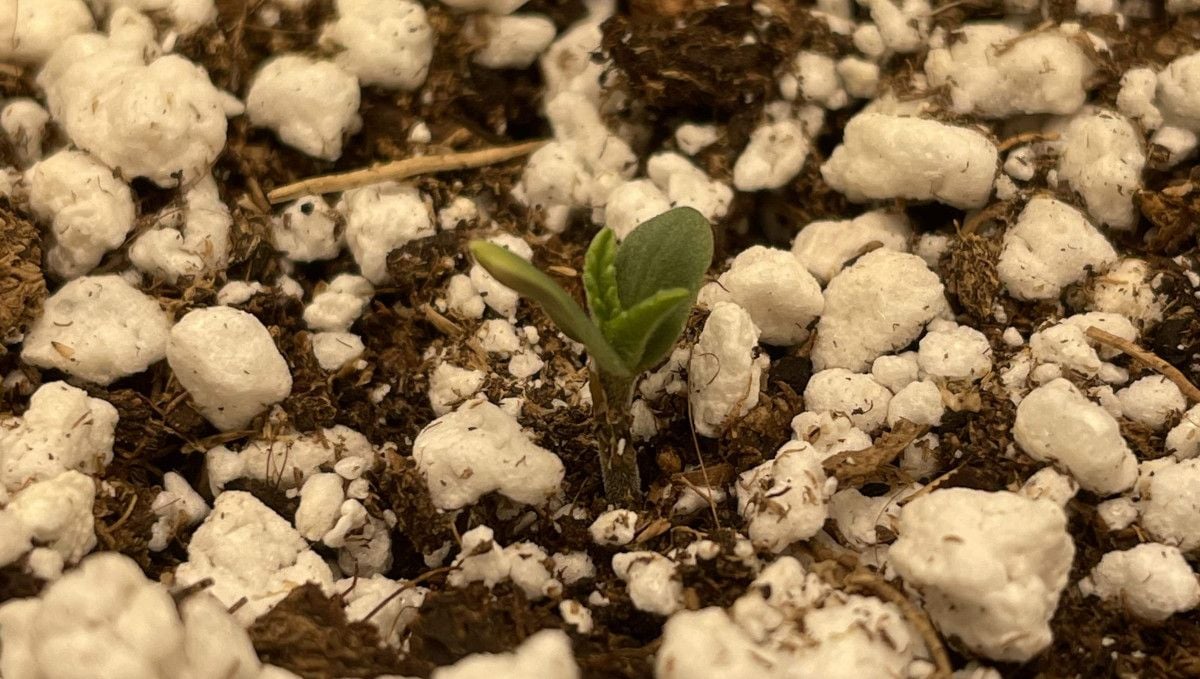
When growing Purple Lemonade Auto, or any cannabis strains for that matter, it’s extremely important to modulate humidity and watering. During this delicate time in the growing cycle, young seedlings are vulnerable to plant pathogens. Many of these diseases thrive in wet and humid conditions. Many beginners end up inhibiting or even killing their plants by overwatering them. This causes a problem in numerous ways. For example, plant roots actually intake oxygen. Adding too much water can suffocate plants. Plus, many plant pathogens are anaerobic in nature, meaning they thrive in oxygenless environments. When caring for seedlings, only water again once the top layer of the growing medium becomes completely dry.
4. Early Veg | Week 2
In any autoflower week-by-week progress, the second week is the time when seedlings actively develop the root system and not much is happening above ground. The young plant likes warm temperatures and high RH.
By this time, you should also figure out the perfect distance from the light. The idea is to not let the seedling stretch too much so that she looks weak and lanky. On the other hand, be sure not to cause any light stress either.
| Plant Height: | 3.5“ (9 cm) | Humidity: | 55% |
|---|---|---|---|
| Distance to Light: | 22“ (56 cm) | Water per Day: | 0.53 gal (2 l) |
| Day Temp: | 82°F (28°C) | pH: | 6.5 |
| Night Temp: | 70°F (21°C) | Smell: | None |
Purple Lemonade Auto seedling spent the second week of the vegetative phase still covered with the bottom half of a plastic bottle. This was the first time the grower tried this controversial method. And probably the last because he didn’t like the result.
He thought this seedling was growing too slowly compared to his plants in previous cycles, and when he finally removed the bottle, it seemed that the progress became more noticeable. To be honest, the seedling Iooked big and strong despite all this.
By the way, this was actually marked as the FIRST week in the journal, but we don’t quite agree. We checked the dates and thought that the timeline was off by at least 2 or maybe 3 or 4 days. And besides, no 7-day weed plant looks as developed as in the picture below on the right. More like 9 days if not 10 or even 11.
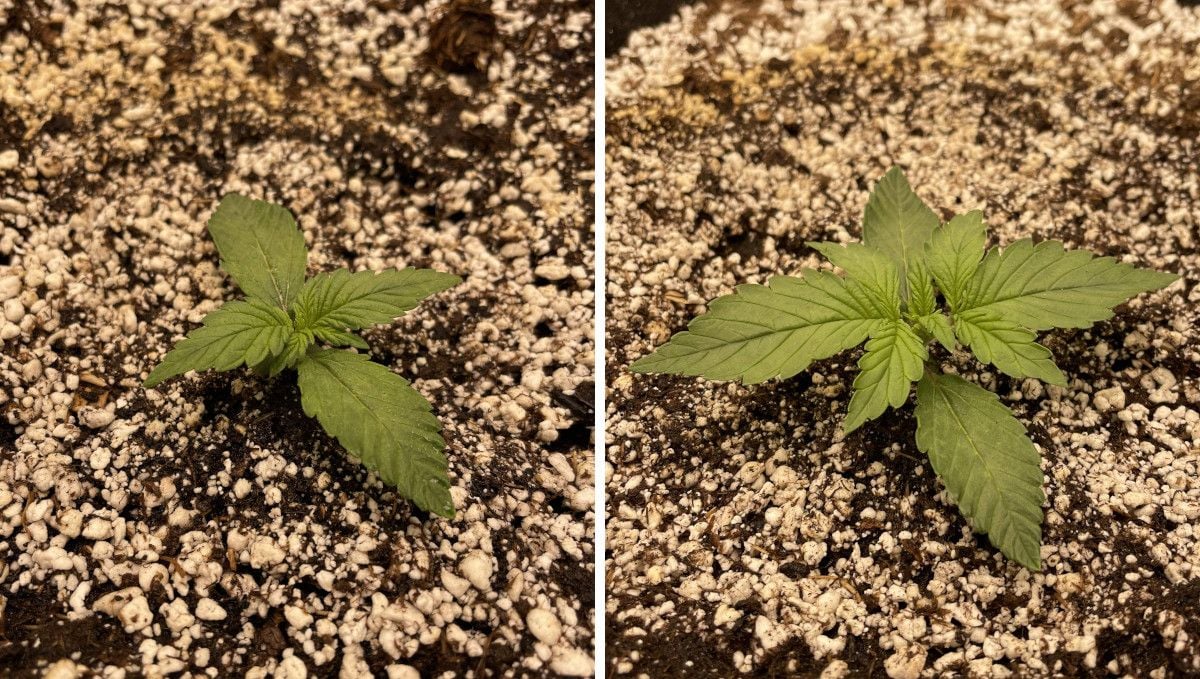
5. Mid Veg | Weeks 3-4
In the second half of the first month, healthy autoflowers “explode” as they hurry to develop as many leaves and side branches as they can before the vegetative phase is over and the pre-flowering stage begins. This is the time when most indoor gardeners begin to train their autos, trying to make them wide and low.
Some risk topping their autos, but generally it’s safer to just low-stress train them. LST enables you to have a flat canopy of equal size nugs. Since all of them are at the same distance from the light and none are in the shade, you’ll have no “popcorn” buds at harvest.
| Plant Height: | 3.5“ (9 cm) | Humidity: | 55% |
|---|---|---|---|
| Distance to Light: | 22“ (56 cm) | Water per Day: | 0.53 gal (2 l) |
| Day Temp: | 82°F (28°C) | pH: | 6.5 |
| Night Temp: | 66°F (19°C) | Smell: | None |
Remember that this Purple Lemonade Auto was planted straight into the final 20L pot? This is optimal for autoflowers because it lets you avoid repotting and potential stress associated with it. On the other hand, having a small seedling in a large container presents another conundrum—with watering.
The grower had been watering the area around the seedling, slowly working his way towards the edge of the pot, and finally, on day 14, he reached it. He saturated the pot with 4 liters of a feeding solution that day.
Since he had mixed in 50% of perlite, the fertigation was indeed quite frequent—every other day. Usually, if you grow weed in soil and use such a big container, you can water once every 3-4 days at the beginning of the grow stages.
At the beginning of week 3, the main stalk was tied down for the first time, and in five days the side branches were long enough to be LSTd too.

Later, the guy would regret pinning down the branches too close to the ground. He thought that maybe this was ‘choking’ them and thus lowered the yield.
The plant also needed defoliation, although it had not been planned initially. The thing is that some of the leaves got practically buried in the soil. It was better to remove them altogether.
6. Transition (Pre-Flower) | Week 5
The very start of cannabis flowering stages—when plants show first pistils on top and begin to stretch—is the perfect time to train them heavily and get a nice flat canopy with every top at the same distance from the light. That’s what our gardener did, and quite skillfully too.
| Plant Height: | 3.5“ (9 cm) | Humidity: | 55% |
|---|---|---|---|
| Distance to Light: | 22“ (56 cm) | Water per Day: | 0.53 gal (2 l) |
| Day Temp: | 82°F (28°C) | pH: | 6.5 |
| Night Temp: | 66°F (19°C) | Smell: | None |
Besides the last bout of heavy low-stress training, the grower kept removing those fan leaves that weren’t getting much light but were shading lower bud sites. After this, everything was ready for the flowering stretch, and there were already lots of pistils on every top.
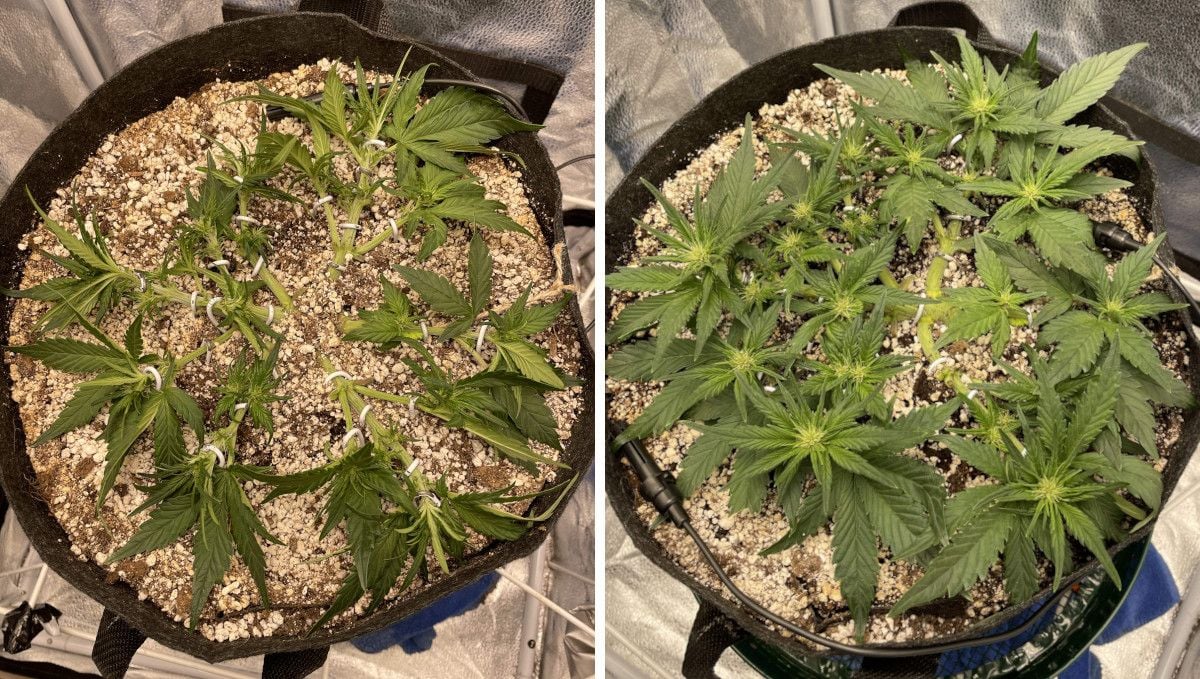
7. Early Flower | Weeks 6-7
When your autoflower flowering stages begin, the first thing you notice is not the swelling of the buds but the elongation of the branches. This is what we call “flowering stretch”, and for many newbies, it comes as a complete surprise. The height chart below will give you a clear idea of how that happens:
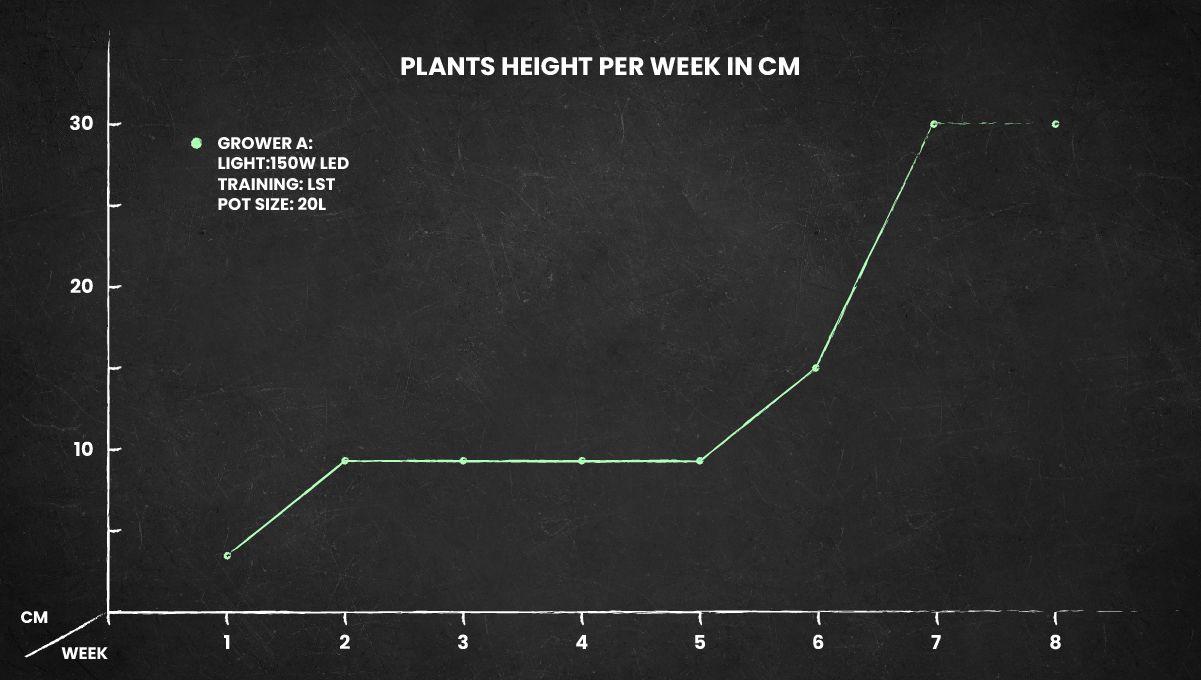
Remember that after the flowering has begun, your auto may stretch anywhere from 50% to 300%. It mostly depends on genetics. And after a while, the flowers begin to stack up too, and your cannabis starts to smell. So if you haven’t yet installed a carbon filter, now is the time.
| Plant Height: | 3.5–6“ (9–15 cm) | Humidity: | 55% |
|---|---|---|---|
| Distance to Light: | 22“ (56 cm) | Water per Day: | 0.53 gal (2 l) |
| Day Temp: | 79°F (26°C) | pH: | 6.5 |
| Night Temp: | 66↘64°F (19↘18°C) | Smell: | Weak |
This Purple Lemonade was stretching all through the 6th and 7th week. However, she didn’t get tall. The flowers were stacking up, bleeding the purple from the calyxes onto the leaves. It was also around this time that the first trichomes began to form.
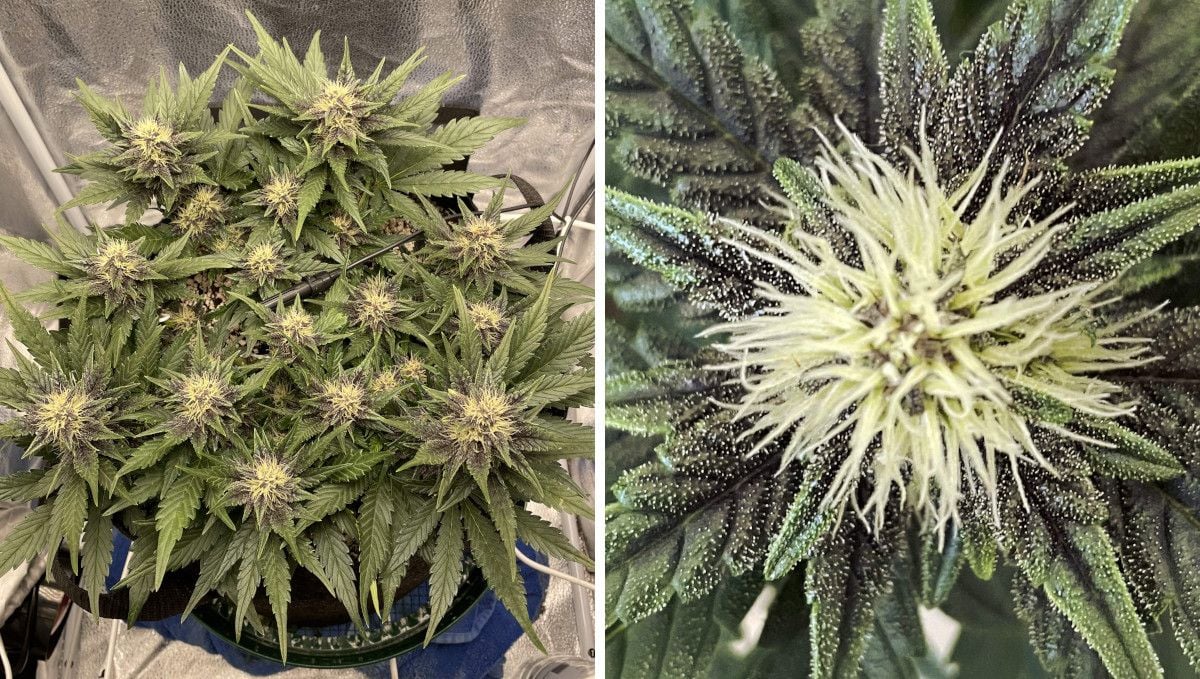
The lady was so compact and symmetrical that she didn’t need any canopy management. Well, except for some minor defoliation because a few fan leaves were blocking lower flowers. So the only thing she really needed was feeding.
She had received her first meal on day 9—long before most gardeners would start to feed their plants. At least, when they grow in soil and with so much of it (20L). Nevertheless, this robust and healthy Purple Lemonade Auto reacted very well to the generous feeding. Here’s what she received (all products, except one, were by Advanced Nutrients):
- pH Perfect combo (Grow, Micro & Bloom), the sources of all essential macro- and micro-nutrients; the grower used them in equal proportions throughout all grow stages,
- B-52, a seaweed and kelp extract with lots of potassium; recommended for use in the seedling stage and then again through different stages of flowering,
- Voodoo Juice, a host of beneficial microbes to create a big and healthy root ball, given twice: in the seedling stage and again during the transition to the flowering stage,
- Vitalink CalMag, besides calcium and magnesium, contains iron, is essential for mediums such as coco where these three nutrients get easily depleted,
- Rhino Skin, another mild potassium booster; more importantly, contains silicon; gives robustness to the cell walls, and makes branches capable of supporting heavy flowers at harvest,
- Bud Candy, a sweet treat for the whole duration of the flowering time; these cranberry and grape extracts boost the aroma and the taste of your buds like nothing else,
- Big Bud, potassium again, this time also with some phosphorus; together these two micronutrients accelerate the production of heavier and denser flowers,
- Overdrive, given in the final weeks of the flowering stage, this rich P-K formula, with some nitrogen and magnesium to boot, gives the second wind to the process of bud formation.
Take a look at the complete nutrient schedule for the whole of the grow cycle:
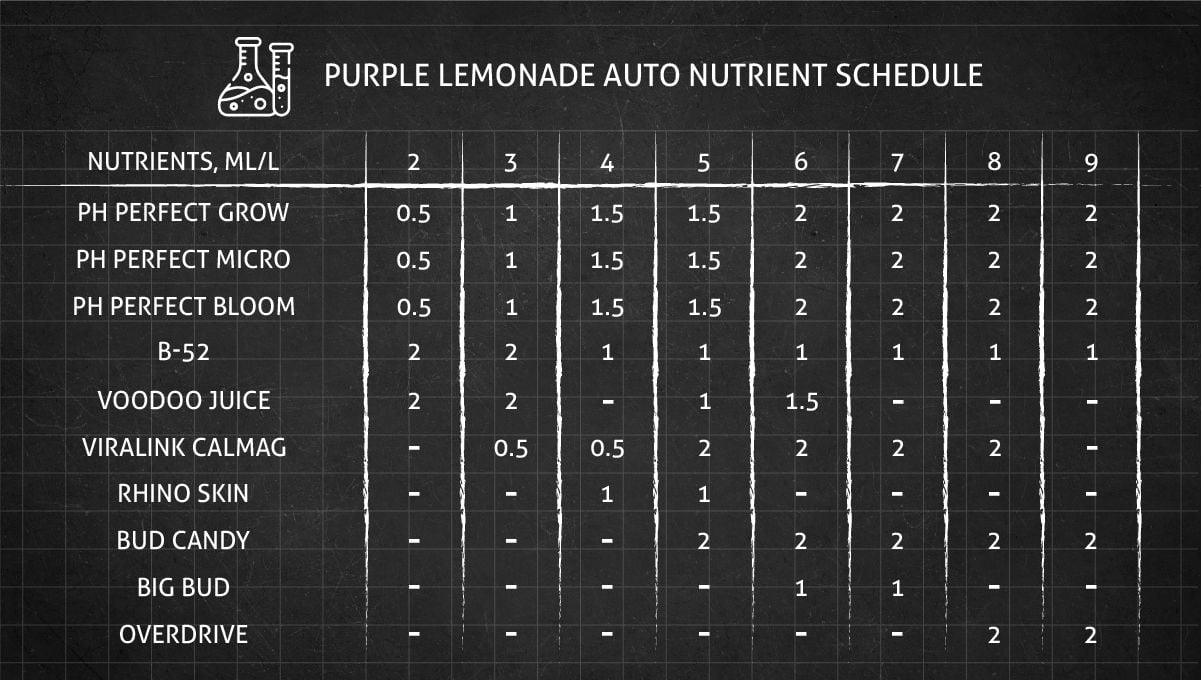
8. Mid Flower (Bulk Phase) | Weeks 8-9
When reviewing Purple Lemonade Autoflower week-by-week journals, we noticed that this strain had a lot of mature trichomes by this time, but new calyxes and new white pistils kept growing. So never hurry with the harvest if you want bigger yields.
In these later stages of flowering, it’s a good idea to lower the relative humidity to protect the swelling colas from mold and bud rot. Also, if you can, try to lower the day temperature by a couple of degrees. Slightly cooler air is better for the production of THC and terpenes. And in purple varieties, it also brings out the color.
| Plant Height: | 12“ (30 cm) | Humidity: | 50% |
|---|---|---|---|
| Distance to Light: | 18“ (46 cm) | Water per Day: | 0.53 gal (2 l) |
| Day Temp: | 82°F (28°C) | pH: | 6.5 |
| Night Temp: | 64°F (18°C) | Smell: | Normal↗Strong |
Weeks 8 and 9 looked like they’d be the last in this Purple Lemonade Auto life cycle. The gardener changed Big Bud for Overdrive hoping for a prompt and strong finish.
And the buds were indeed getting bulkier and heavier every day. Almost all of the trichomes got milky although only a little over 50% of pistils have turned amber so far. Which is yet another argument to look at the trichs and not the hairs when determining cannabis flowering stages.

In the last but one week, the grower tried a flush with pHd water to try and get rid of a small issue. The thing is that some leaves became spotty and started to wilt at the ends. The guy thought it was because of too much CalMag. Frankly, symptoms like this usually mean exactly the opposite—a calcium deficiency.
Anyway, the issue didn’t get any worse, and besides, the whole seed-to-harvest cycle was almost over. On day 61, Purple Lemonade Auto received her penultimate flush.
The purpose of flushing is to get rid of built-up salts. And not only in the medium but in the tissues of the plant as well. Don’t ignore this chore if you want clean, smooth-tasting product.
9. Ripening And Harvest | Week 10
Purple Lemonade Auto appears to be a very fast-flowering variety because, in all reports we have looked at, she finished within 10-11 weeks from seed and was perfectly mature by this time. And in this grow, she was chopped even before the 10th week was out. So plan your final flush accordingly.
| Plant Height: | 12“ (30 cm) | Humidity: | 40% |
|---|---|---|---|
| Distance to Light: | 18“ (46 cm) | Water per Day: | 0.53 gal (2 l) |
| Day Temp: | 79°F (26°C) | pH: | 6.5 |
| Night Temp: | 64°F (18°C) | Smell: | Strong |
This compact and incredibly fast Purple Lemonade Auto didn’t get a chance to be flushed properly—for something like two weeks. The reason was that the grower didn’t expect her to mature so suddenly.
He managed to flush her only two times—on days 61 and 64, and by this time, trichomes started to turn amber. The guy removed some more fan leaves that were blocking the light in the middle and simply gave his girl another couple of days to dry out before the chop.
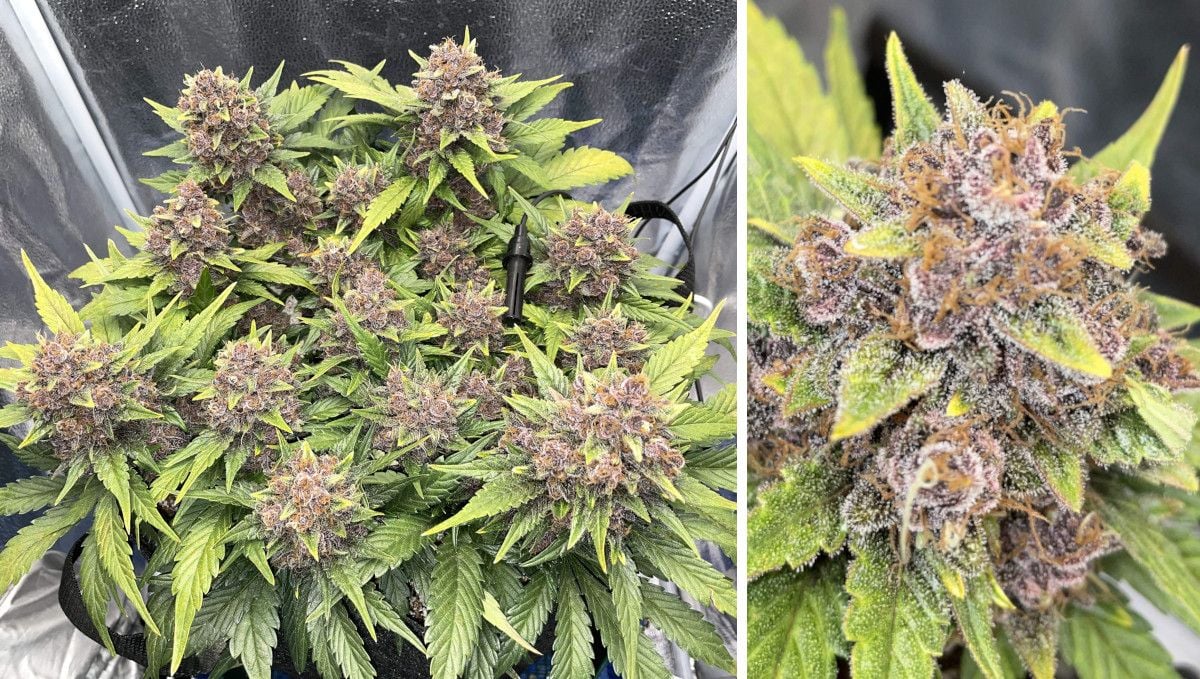
10. Yield and Smoke Report
The grower harvested his beautiful little lady on day 68 from seed (with about 5-10% amber trichs). The lower bud sites were a bit less mature and could have still gained some weight, but the grower didn’t want to harvest in increments. So the final haul was 68.5 g (2.42 oz) dry.
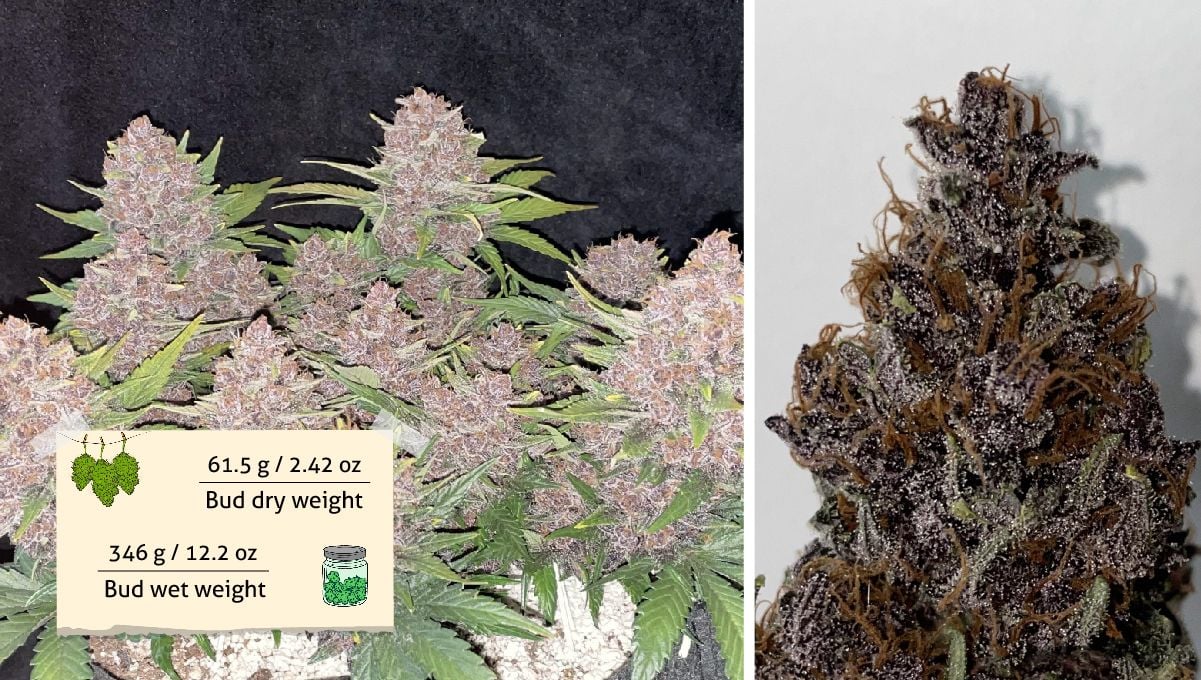
The guy only described the flavor and effect of a smaller nug that was halfway down a branch and was dryer before the others. (And it was after only a few days of drying.) So it wasn’t Purple Lemonade Auto at its best. Nevertheless, ground-up buds smelled strong—of cookies, citrus, and fuel—smoked smooth, and tasted sour and gave a nice cerebral high which after a while turned into a deep but focused stone. A perfect nighttime smoke.
11. In Conclusion
Purple strains are everybody’s favorites, and Purple Lemonade Auto is no exception. She is even better than the average purple variety in many respects: buds are denser, and such characteristics as growth patterns, size, and yield are more consistent.
The buds have understandably a huge bag appeal and an incredibly pleasant smell of lemons. They produce a smoke that is potent by any standards (thanks to up to 22% THC). Despite a considerable Indica presence, the effect does not glue you to the couch but pleasantly relaxes you and motivates you to do things.
The journey from seed to harvest is comfortably short and carefree. A lot of calyxes are smokable after just 8 weeks, but new ones keep growing. So, if you’re not in a hurry, wait for a couple of more weeks, and Purple Lemonade will thank you with bountiful yields. Especially, if you’re blessed with an occasional giant pheno.
Most plants stay nice and compact but have a lot of branches even if left untrained. And training—either LST or HST—doesn’t seem to slow them down or negatively affect final results.
In short, Purple Lemonade Auto is a straight road to having a top-shelf product in a very short time. Happy growing, everyone!
External References
- Seeking suitable agronomical practices for industrial hemp (Cannabis sativa L.) cultivation for biomedical applications, I.F.García-Tejero et al., July 2019
- Global patterns of domestic cannabis cultivation: Sample characteristics and patterns of growing across eleven countries, Gary R Potter et al., Dec 2014
- The influences of cultivation setting on inflorescence lipid distributions, concentrations, and carbon isotope ratios of Cannabis sp., Forensic Science International, March 2016
- Plant growth-promoting rhizobacteria (PGPR) in Cannabis sativa ‘Finola’ cultivation: An alternative fertilization strategy to improve plant growth and quality characteristics, G. Pagnani, M. Pellegrini et al., Industrial Crops and Products, November 2018








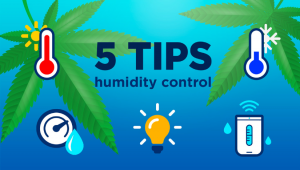

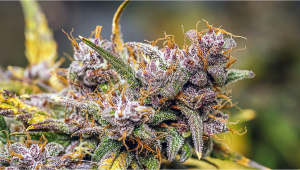


Comments